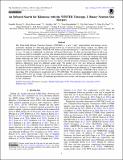An Infrared Search for Kilonovae with the WINTER Telescope. I. Binary Neutron Star Mergers
Author(s)
Frostig, Danielle; Biscoveanu, Sylvia; Mo, Geoffrey; Karambelkar, Viraj; Dal Canton, Tito; Chen, Hsin-Yu; Kasliwal, Mansi; Katsavounidis, Erik; Lourie, Nathan P; Simcoe, Robert A; Vitale, Salvatore; ... Show more Show less
DownloadPublished version (1.504Mb)
Publisher with Creative Commons License
Publisher with Creative Commons License
Creative Commons Attribution
Terms of use
Metadata
Show full item recordAbstract
The Wide-Field Infrared Transient Explorer (WINTER) is a new 1 deg2 seeing-limited time-domain survey instrument designed for dedicated near-infrared follow-up of kilonovae from binary neutron star (BNS) and neutron star–black hole mergers. WINTER will observe in the near-infrared Y, J, and short-H bands (0.9–1.7 μm, to JAB = 21 mag) on a dedicated 1 m telescope at Palomar Observatory. To date, most prompt kilonova follow-up has been in optical wavelengths; however, near-infrared emission fades more slowly and depends less on geometry and viewing angle than optical emission. We present an end-to-end simulation of a follow-up campaign during the fourth observing run (O4) of the LIGO, Virgo, and KAGRA interferometers, including simulating 625 BNS mergers, their detection in gravitational waves, low-latency and full parameter estimation skymaps, and a suite of kilonova lightcurves from two different model grids. We predict up to five new kilonovae independently discovered by WINTER during O4, given a realistic BNS merger rate. Using a larger grid of kilonova parameters, we find that kilonova emission is ≈2 times longer lived and red kilonovae are detected ≈1.5 times further in the infrared than in the optical. For 90% localization areas smaller than 150 (450) deg2, WINTER will be sensitive to more than 10% of the kilonova model grid out to 350 (200) Mpc. We develop a generalized toolkit to create an optimal BNS follow-up strategy with any electromagnetic telescope and present WINTER's observing strategy with this framework. This toolkit, all simulated gravitational-wave events, and skymaps are made available for use by the community.
Date issued
2022-02-01Department
Massachusetts Institute of Technology. Department of Physics; LIGO (Observatory : Massachusetts Institute of Technology); MIT Kavli Institute for Astrophysics and Space ResearchJournal
The Astrophysical Journal
Publisher
American Astronomical Society
Citation
Frostig, Danielle, Biscoveanu, Sylvia, Mo, Geoffrey, Karambelkar, Viraj, Dal Canton, Tito et al. 2022. "An Infrared Search for Kilonovae with the WINTER Telescope. I. Binary Neutron Star Mergers." The Astrophysical Journal, 926 (2).
Version: Final published version